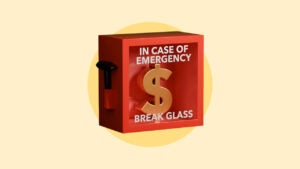Getting a mortgage after bankruptcy: What you need to know

Key takeaways
- You can get a mortgage after declaring bankruptcy, but how soon depends on the type of mortgage and the type of bankruptcy you filed.
- Depending on whether you filed Chapter 7 or Chapter 13, it'll take two or four years to qualify for a conventional mortgage, one or two years for FHA or VA loans, and one or three years for USDA loan.
- A bankruptcy lowers your credit score, but you can still qualify for a mortgage if you can provide lenders with assurance you'll repay.
- You'll want to rebuild your credit, write a letter of explanation, and pay down debt to get into the best position for mortgage preapproval.
Declaring bankruptcy means admitting that you’re unable to pay your bills, and working out an arrangement to restructure or discharge your current debts. Not surprisingly, going bankrupt can make it tough to take on any fresh debt — and a mortgage is a big one.
Tough, but not impossible. Here’s how you could get a mortgage after bankruptcy.
Can you get a mortgage after bankruptcy?
Yes, you can — but it won’t be easy. Going bankrupt usually means a big drop in your credit score and a big negative point on your credit report. With bad credit, you’ll struggle to qualify for any new loans. The fact of the bankruptcy will be another mark against you, and don’t think you can hide it from lenders: It’s recorded on your credit report, and stays there for seven to 10 years. So it’ll come up when they run a credit check.
You can’t apply for a mortgage close on the heels of a bankruptcy. You’ll have to wait until a court or creditor approves your bankruptcy plan, you’ve discharged certain of your debts (as per your plan), and you’ve fulfilled certain waiting-period requirements.
The good news is you won’t be prohibited indefinitely from qualifying for a mortgage following a bankruptcy. After a minimum number of years, you can apply for a home loan. That said, if you have reliable income capable of meeting repayments, work on rebuilding your credit, and provide a letter of explanation detailing why you went bankrupt and what improvements you’ve made since, lenders might approve you for a post-bankruptcy mortgage.
How soon can you get a mortgage after bankruptcy?
It depends on the type of mortgage you want to get — each home loan program has a different waiting period — but also exactly how you originally declared bankruptcy.
There are two main types of bankruptcy: Chapter 7 and Chapter 13. The former is the most common type, and it involves a liquidation of your assets, which go towards discharging most or all of your outstanding debt. A Chapter 7 bankruptcy is usually approved for those with limited income to repay what they owe. It stays on your credit report for up to 10 years.
A Chapter 13 or reorganization bankruptcy involves creating a plan to repay your creditors, taken from your earnings, at a percentage of what you owe them — up to 100 percent. This repayment plan takes longer than a Chapter 7, often three to five years, and it has to be approved by a bankruptcy court. It will stay on your credit report for seven years maximum.
Here’s an overview of how long after bankruptcy you can get a mortgage, depending on the kind of loan and the chapter you file:
Variety of mortgage loan |
Waiting period after filing |
|
|---|---|---|
| Chapter 7 | Chapter 13 | |
| Conventional | 4 years | 2 years after discharge or 4 years after dismissal |
| FHA | 2 years | 1 year |
| VA | 2 years | 1 year |
| USDA | 3 years | 1 year |
Chapter 7 bankruptcy
Leslie Tayne, attorney and founder of Tayne Law Group in Melville, New York, says you’re eligible for a mortgage a few years after a Chapter 7 discharge of debt. Exactly how long ranges from two to four years, depending on the sort of mortgage you want:
- FHA/VA loan: two years after filing
- USDA loan: three years after filing
- Conventional loan: four years after filing
If you can’t wait it out, Ashley Morgan, a debt and bankruptcy attorney in Herndon, Virginia, says there are limited-availability programs that can allow a Chapter 7 debtor to qualify for FHA financing in as little as one year. “But you have to prove that your debts or financial issues were due to extreme circumstances outside your control,” Morgan says, “such as the death of a spouse or divorce.”
Chapter 13 bankruptcy
The waiting periods following a Chapter 13 bankruptcy are, thankfully, shorter, “because the borrower has already taken time to improve their financial situation through the Chapter 13 bankruptcy process, which involves some repayment,” Tayne says. The waiting periods are:
- FHA, VA, or USDA loan: one year from filing
- Conventional loan: two years after discharge or four years after dismissal
Tayne explains that a “discharge” happens when you complete your repayment plan laid out by the court and the matter is discharged by the court, meaning you’ve successfully paid back your creditors.
“Dismissal” occurs when you cannot complete the repayment plan and the case is, therefore, dismissed by the court — essentially meaning the bankruptcy was not successful. The waiting periods are shorter for discharges because the filer has been working toward improving their credit through the repayment process.
However, you may qualify for a mortgage even during the Chapter 13 process if you can demonstrate that you’ve made 12 months’ worth of on-time payments and get court approval.
“Here, the court will often want to review the financing terms and compare your monthly mortgage payment to the rent payment list in your bankruptcy,” Morgan says. “If your new monthly mortgage payment would be higher, you usually have to show how you will afford the increased payment and why that money shouldn’t go to creditors.”
What type of mortgage can you get after bankruptcy?
After a bankruptcy has discharged and closed, you may be eligible for a conventional mortgage as well as an FHA, VA or USDA loan if you qualify. “But you’ll need to meet the waiting period rule and show that you’ve worked to repair your credit,” Tayne says.
Each of these post-bankruptcy home loan options has slightly different criteria..
Conventional loan
Most conventional mortgages will require a credit score of at least 620. Your credit score and the amount you’ll be able to commit to a down payment (many lenders prefer 20 percent) will affect the interest rate you are quoted.
FHA loan
For an FHA loan, you’ll need to demonstrate that you have improved your credit and haven’t taken on any additional debt since the bankruptcy. FHA loans “generally require a lower minimum credit score and down payment than conventional mortgages,” Tayne says (as low as 580 and 3.5 percent down, or 500 and 10 percent down).
USDA loan
To get a USDA loan, you must be a low- to moderate-income borrower living in a United States Department of Agriculture-designated rural area. If so, you can apply for one of these mortgages, which don’t require a down payment or minimum credit score.
VA loan
Eligible veterans, service members and qualified surviving spouses with a minimum credit score of 620 can apply for a VA loan for no money down.
How to apply for a mortgage after bankruptcy
Applying for a mortgage post-bankruptcy is similar to a regular application — only with a few extra steps. That way, when your bankruptcy discharges, you’ll be on the road to homeownership.
1. Rebuild your credit
Put your waiting period to good use: Bouncing back from bankruptcy’s hit to your credit score takes time. The first step is to open a secured credit card. You’ll make a deposit that becomes your credit limit. With some issuers like U.S. Bank and Capital One, if you make on-time payments, they might eventually refund your deposit to make your credit card unsecured (and maybe even raise your credit limit).
On this card, as well as any others you have, take extra care to pay balances in full and on time (delinquencies also make a major dent in your score). Along with establishing a solid payment history, you’ll also want to keep your debt down. The fewer obligations you have, the better your debt-to-income ratio, a key factor mortgage companies examine when determining mortgage eligibility.
2. Apply for preapproval
Once the waiting period expires, you’re free to apply for preapproval. You’ll need to supply proof of income such as a W-2, paystub, or bank statements.
A mortgage preapproval lets you know how much the lender might approve you for, so when you go home shopping, you have a better idea of what you can afford. And it gives sellers assurance that you’re in a good position to acquire a mortgage.
3. Explain your bankruptcy to your prospective lender
Since your lender is going to discover your bankruptcy, get out in front of the issue by accounting for it in writing. A letter of explanation tells your lender why you filed for bankruptcy. Include any circumstances that altered your financial situation such as a job loss, divorce, unexpected medical condition or death.
Also, you’ll want to delineate how your personal finances and financial practices have changed since filing for bankruptcy: larger income, cleared debts and better repayment history.
Include this letter with your application for preapproval. Your aim is to be forthright, take responsibility for the past and reassure the lender about the future — you’re no longer a big risk. Although mortgage underwriting is largely a by-the-numbers game now, this personal touch could tip the balance in your favor.
4. Be responsive to lender’s requests
When a lender reviews your application, it isn’t uncommon for them to have questions — especially for someone with your history. They might supply a list of credit inquiries and ask why they occurred (especially if you’ve been applying for a lot of different loans or credit cards).
Be responsive and honest about your financial situation. Doing so gives them a more accurate depiction and can help you know sooner whether you’ll receive preapproval. If you don’t get it, you can request reasons for the denial, and in some cases, they might work with you, so you can get your application where it needs to be.
Bottom line on getting a mortgage after bankruptcy
Overall, bankruptcy should not prevent you from getting a future mortgage, but you want to ensure your timing is right.
“You don’t want to rush into a financial commitment if you aren’t going to be able to afford new debt,” Selita says. “Consider the long-term gain of potentially waiting to purchase a home until after your credit score further improves.”
Additional reporting by Taylor Freitas
Why we ask for feedback Your feedback helps us improve our content and services. It takes less than a minute to complete.
Your responses are anonymous and will only be used for improving our website.
You may also like

How to get an emergency loan in 5 simple steps

How to buy a house with bad credit

Buying a home after foreclosure




